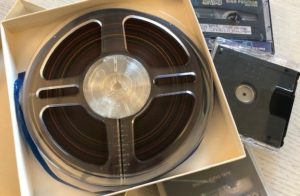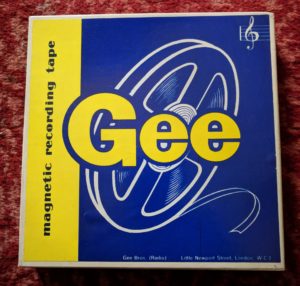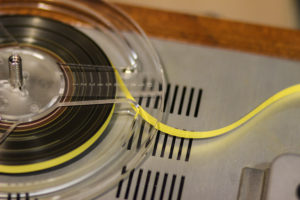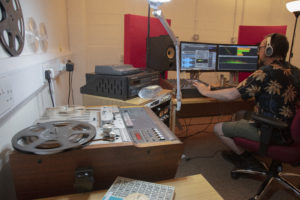This Q&A is with our Digital Engagement Officer, Rachel Cartwright and Katie Scaife, Project Manager of Unlocking our Sound Heritage, Bristol Archives.

A pile of audio formats © Bristol Archives
Unlocking Our Sound Heritage (UOSH) are delivering face to face 2-day training sessions across the South West in September and October.
We are delighted to collaborate with Katie to bring a tailored 1.5 hour online training session for Accredited museums in the South West on Thursday October 14th which you can book via Eventbrite.
Hello Katie, firstly can you tell us how this project came about?
Unlocking Our Sound Heritage (or UOSH for short) is part of a larger project, Save Our Sounds, which is the British Library’s programme to preserve the nation’s sound heritage.
Our sound collections are under threat, both from physical degradation of the different audio formats over time, and because the means of playing them disappear from production. Global archival consensus is that we have approximately 15 years in which to save our sound collections by digitising them before they become unplayable and are effectively lost.
As part of Save Our Sounds, the British Library undertook a national audit to map the condition of sound collections around the country and identify threatened collections. Then UOSH was launched; with funding from the National Lottery Heritage Fund, the British Library set up a network of audio preservation centres across the UK, with expert staff in place to catalogue, digitise and preserve sounds.
These centres, called ‘hubs’, each digitise, catalogue and preserve audio collections from their catchment area. Each hub focusses on the most unique, rare, and at-risk recordings in their area, as identified through the national audit.

Gee tape reel box © Bristol Archives
The hub for South West England, the one I work for, is at Bristol Archives. There are nine other hubs and we are all working to the same standards, sending the digital recordings we create to the British Library who has undertaken to preserve them all in perpetuity, bulk uploading them to new technologies as they arise.
Our hub started working in October 2018, and we have until the end of March 2022 to complete our work. While we will have preserved by then about 4500 archival audio items, we know there is lots more out there needing to be digitised.
You can read more about UOSH and the other hubs here.
The age of a collection or the format it’s on is not always the biggest predictor of how close it is to being lost. Our highest failure rate – because sometimes we are too late – is with CDs, especially CD-Rs (Recordable CDs) – Katie Scaife
What have been the main objectives of the project?
There are four strands to our project:

A reel-to-reel machine © British Library
- Digitise analogue audio recordings to transform access to and preserve our audio heritage. This is the meat and potatoes of our hub’s work. We’ve had to revise our preservation target down slightly due to the pandemic, but we will complete catalogue and preserve about 4500 items during our project period.
- Raise awareness of the importance and value of the nation’s sound heritage. This is also very important! OK, all our strands are important. Through talking about our work with organisations like South West Museum Development, we are banging the drum about the beauty, wonder, and intimacy of audio collections. This is also the reason we are delivering training sessions about how to care for, preserve, catalogue and share you audio collections at venues around the south west this autumn.
- Create sustainable centres of audio digitisation preservation. We are looking at ways to keep the sound room working, so we can carry on preserving all the audio collections we haven’t had a chance to work on through UOSH.
- Involve new audiences with their audio heritage. We want this audio heard! We and our collection partners run a range of community and schools projects enabling people to hear, enjoy, and respond to audio recordings. We also have a part-time rights clearance officer as we need to clear about 10% of the recordings we digitise for online access. The British Library will launch a new universal player early next year with100,000s of recordings on it, the result of rights clearance done by the hubs and at the British Library. This resource will allow these recordings to be heard, online, for sometimes the first time in decades.
Describe your role in this project and what does a typical day look like for you?
As the project manager my work centres on ensuring everything progresses smoothly and I lead on the delivery for each strand of this project. Recently my days are spent organising our autumn training days, supporting the other team members (the cataloguer, audio engineer and rights clearance officer), and also helping to run and promote our engagement projects. I can’t forgot to mention budget monitoring and other essential tasks that are not so glamorous but so important to keep the project on track!
What types of audio collections are you digitising?

A sound room with the engineer at work © Bristol Archives
The bulk of the collections are oral history. They are truly fascinating first-hand reports from the past, talking about a way of life that is sometimes already forgotten. We are digitising a range of formats; reel-to-reel tapes, cassettes, micro- and mini-cassettes, Digital Audio Tapes (DATs), CDs, minidiscs, and more recently we’ve acquired the kit to digitise vinyl discs and 78s.
What is the most interesting thing you have uncovered so far?
That’s a hard one! In fact, I’m going to sit on the fence and say I don’t want to say until we’re finished. There have been so many interesting recordings – funny, moving, rich, surprising – that I wouldn’t like to pick one, and there’s always a chance the best is yet to come.
What main piece of advice would you give to anyone reading this who works with a collection that has yet to be digitised audio?
Get to know your audio collections and start making a plan to preserve them. Perished audio is lost forever. Also, a big thing we’ve learnt and want to share is that the age of a collection or the format it’s on is not always the biggest predictor of how close it is to being lost. Our highest failure rate – because sometimes we are too late – is with CDs, especially CD-Rs (Recordable CDs). They are barely lasting a decade before the data on them begins to degrade. They are not a long-term data storage solution. If you have anything on CD or CD-R, transfer it – fast!
Find out more
You are interested in finding out more or attending the 2-day face to face training sessions run by Unlocking Our Sound Heritage across the South West this Autumn, find out more on their Eventbrite page.
